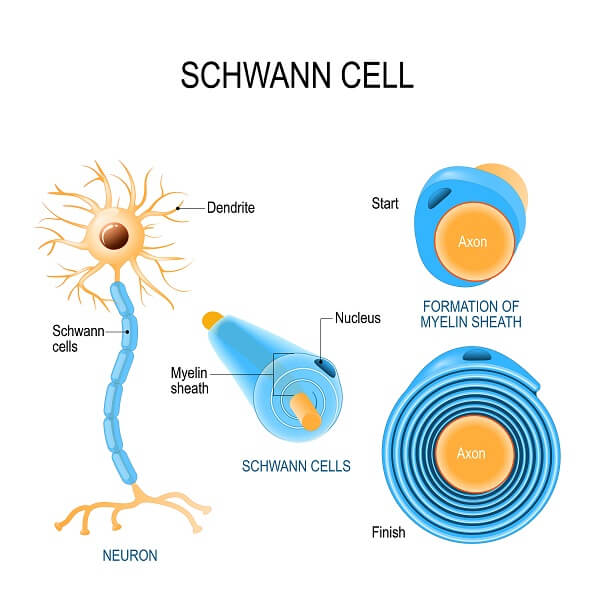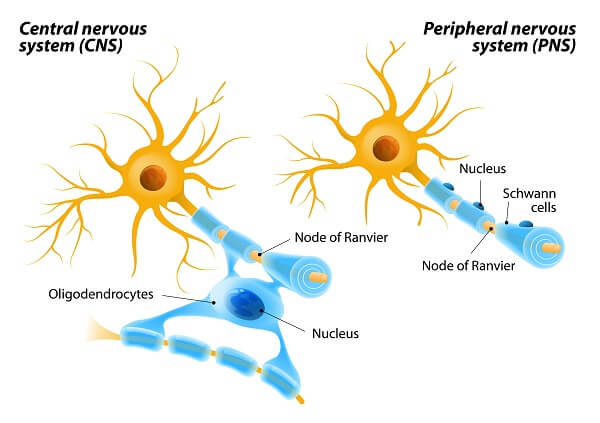Definition
Schwann cells are a type of glial cell that surrounds neurons, keeping them alive and sometimes covering them with a myelin sheath. Schwann cells are present in the peripheral nervous system, whereas oligodendrocytes are similar cells found in the central nervous system. These cells surround nerves to hold them in place, supply neurons with nutrients and oxygen, insulate the pathways between nerves, and ensure neurons do not become infected.
Overview
Nerves operate by conducting an electrical impulse through their cell membrane. The signal travels all the way to the end of the nerve cell, where it is chemically transferred to the next nerve cell. It takes a lot of energy and a special shape in order to do this, which renders nerve cells incapable of taking care of themselves.
That is where Schwann cells (and other glial cells) come in. A glial cell can be thought of like a caretaker of a nerve cell. There are many different types of glial cells, depending on which part of the nervous system you are looking at. Schwann cells are specific to the peripheral nervous system, which consists of all of the nerve cells outside of the brain and spinal cord. Schwann cells take on many of the roles that nerve cells cannot complete themselves.

Schwann Cell Function
Schwann cells have 4 basic roles when it comes to supporting nerves. First, they must support the physical location of the nerve and protect it from any outside damage. Thus, most Schwann cells can be found wrapped around the nerves that they protect. Most often, it takes many of these small cells to surround and encapsulate a nerve cell. These cells form connections to the surrounding extracellular matrix and other cells, locking the nerve cell in place and ensuring it makes the connections it needs to.
Second, partly because nerve cells are busy sending nervous signals and partly because they are surrounded by glial cells, Schwann cells must supply the underlying nerve cell with oxygen and nutrients. For this reason, these cells have special membrane functions that allow nutrients and oxygen to easily flow to the nerve cell.
Though not all Schwann cells produce a myelin sheath, insulation is a major function of these glial cells. As they wrap themselves around a nerve, it physically separates the nerve from contacting other nerves, thereby providing the third function of insulation. Some nerve cells are myelinated. Schwann cells create the myelin sheath.
Myelin is a fatty substance produced by glial cells that is non-conductive. Much like wires covered in insulation lose less current, myelinating a nerve cell ensures that the signal is insulated. It has been shown in studies that myelinated nerve cells can transfer signals up to 10X faster than unsheathed nerves.

That is part of the reason that the disease Multiple Sclerosis (MS) can be so devastating. A patient with MS slowly loses the myelin sheaths as Schwann cells die off. This causes sporadic nerve signals, slower nervous signal transfers, and potential nerve damage. This eventually leads to the loss of nervous system function which can bring on symptoms like numbness, blindness, and eventually death.
The final function of Schwann cells can help repair nerve damage that occurs in the peripheral nervous system. Schwann cells phagocytize any broken remnants of cells, helping to recycle them into new nerve cells. In addition to these main functions, these glial cells may also be involved in transmitting nervous signals more directly, destroying pathogens, and generally keeping nerves healthy.
Schwann Cells vs Oligodendrocytes
Schwann cells are very similar to the oligodendrocytes found in the central nervous system. However, there is one important difference. Oligodendrocytes connect to several different nerve cells, forming myelin sheaths around each. By contrast, Schwann cells only surround one nerve cell – and there are often many Schwann cells surrounding a single nerve cell.

This difference is mainly due to the different structures and functions of nerve cells in the central and peripheral nervous systems. In the central nervous system, nerve cells are tightly packed and must maintain very close proximity to each other. Therefore, one oligodendrocyte can easily reach and protect many different neurons and hold them in place. By contrast, nerves are few and far between in the peripheral nervous system. Many Schwann cells may surround these very long nerve cells, helping transmit signals to the most distant parts of the body!
